|
Diseases of Poultry
By Ivan Dinev, DVM, PhD
|
INFECTIOUS BURSAL DISEASE (GUMBORO)
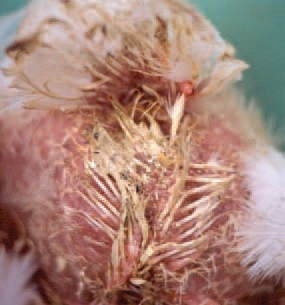
215.Infectious bursal disease (IBD, Gumboro) is an acute, highly contagious viral infection in chickens manifested by inflammation and subsequent atrophy of the bursa of Fabricius, various degrees of nephroso-nephritis and immunosuppression. Clinically the disease is seen only in chickens older than 3 weeks. The feathers around the vent are usually stained with faeces containing plenty of urates.
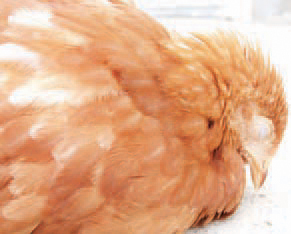
216.The period of most apparent clinical symptoms and high death rate is at the age of 3 - 6 weeks. IBD could however be observed as long as chickens have a functioning bursa (up to the age of 16 weeks). In chickens younger than 3 weeks, IBD could be subclinical, but injured bursa leads to immunosuppression. Also, diarrhoea, anorexia, depression, ruffled feathers, especially in the region of the head and the neck are present.
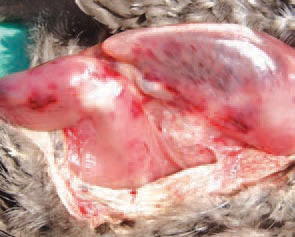
217.A natural IBD infection is mostly observed in chickens. In turkeys and ducks it could occur subclinical^, without immunosuppression. Most isolates of the IBD virus in turkeys are serologically different from those in chickens. In premises, once contaminated with the IBD virus, the disease tends to recur, usually as subclinical infection. The dead bodies are dehydrated, often with haemorrhages in the pectoral, thigh and abdominal muscles.
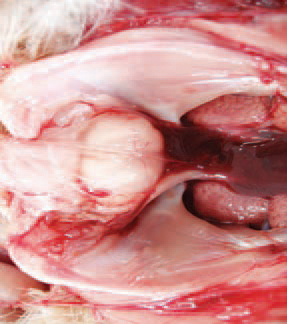
218.The IBD virus belongs to the Birnaviridae family of RNA viruses. Two serotypes are known to exist, but only serotype 1 is pathogenic. The virus is highly resistant to most disinfectants and environmental onditions. In contaminated premises, it could persist for months and in water, forage and faeces for weeks. The incubation period is short and the first symptoms appear 2-3 days after infection. The lesions in the bursa of Fabricius are progressive. In the beginning, the bursa is enlarged, oedematous and covered with a gelatinous transudate.
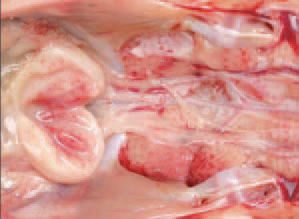
219.IBD virus has a lymphocidic effect and the most severe injuries are in the lymph follicles of the bursa of Fabricius. Most commonly, IBD begins as a serous bursitis.
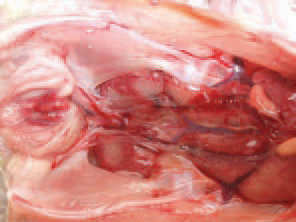
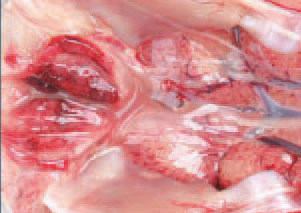
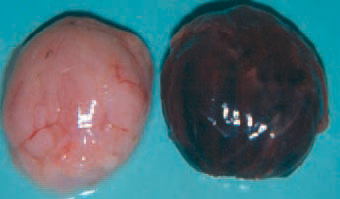
220.221.222.IBD lesions undergo various stages of serous haemorrhagic to severe haemorrhagic inflammation. The morbidity rate is very high and could reach 100%, whereas the mortality rate: 20 - 30%. The course of the disease is 5-7 days and the peak mortality occurs in the middle of this period.
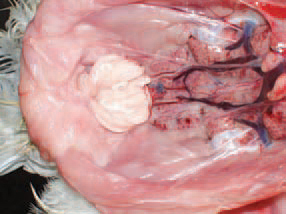

223.224.In some cases, the bursa is filled with coagulated fibrinous exudate that usually forms casts with the shape of mucosal folds. In birds surviving the acute stage of the disease, the bursa is progressively atrophying. Microscopically, an atrophy of follicles into the bursa is observed secondary to inflammatory and dystrophic necrobiotic alterations.
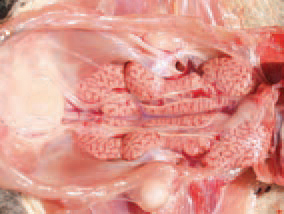
225.The kidneys are affected by a severe urate diathesis. In an acute outbreak and manifestation of the typical clinical signs, the diagnostics is not difficult. The diagnosis could be confirmed by detection of typical gross lesions throughout a patho-anatomical study. IBD should be differentiated from IBH (inclusion body hepatitis). The application of live vaccines in chickens is a key point in the prevention of IBD and should be related to the levels of maternal antibodies.






